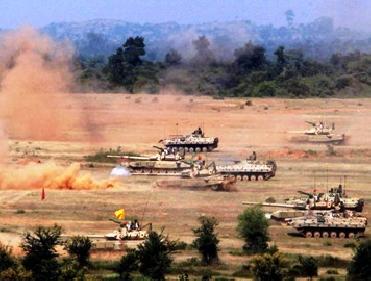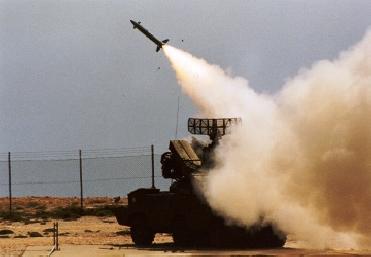
Army tanks taking part during the Indo-US joint exercise 'Yudh Abhyas 09' in Jhansi on Monday. Image credit: PTI
BABINA (PTI): India and the US concluded the largest-ever army exercise here involving tanks, combat vehicles, anti-tank missiles and UAVs while signalling that the two forces were ready for future joint counter-insurgency and anti-terror operations.
“We will be comfortable going with the Indian Army anywhere, anytime. We want to work together as militaries and ensure peace and stability in the Asia-Pacific region,” US Army Commander (Pacific) Lt Gen Benjamin R Mixon told reporters here on Monday.
Asked about the possibility of future joint operations, for example in Afghanistan, he said the Indian government has to take a decision on it.
Indian Army's Director General (Military Operations) Lt Gen A S Sekhon, nodding in approval, said: “Why not? However, this exercise is not targeting anybody or any nation, or for any specific contingency. We cannot be using this kind of force in peace-keeping operations.
“This is only a training exercise to learn from each other's experience in similar type of operations,” said Sekhon to a specific query if future joint operations were possible in the region.
The fortnight-long ‘Yudh Abhyas-09’, that began on October 12, saw the Indian Army's Mechanised Infantry Battalion of 94 Armoured Brigade under Bhopal-based 21 Srike Corps, and the US 2/14 Cavalry of 25 Stryker Brigade Combat Team, testing the Russian-made T-90S tanks and BMP-II armoured personnel carriers (APC) with eight-wheeled Stryker APC capable of carrying nine fully-armed personnel.
Strykers, which were brought to India for the first time, can be transported to any area of operation by loading them on to C-130 cargo aircraft.
India has incidentally bought six C-130J aircraft for its special forces operations and the first Lockheed Martin aircraft is scheduled to arrive in early 2011.
The focus of the exercise was to use firepower of armoured vehicles to neutralise armed insurgents and terrorists in a semi-urban setting and peace-enforcement, including use of force, as mandated by Chapter VII of the UN Peace Keeping Operations.
Pitching for military equipment sales to India, the US troops, during the course of the exercise, demonstrated the capabilities of their Javelin anti-tank missile and the Raven ultra small unmanned aerial vehicles for reconnaissance.
Indian armed forces at present use French-German Milan and Russian Konkur anti-tank missiles, and Israeli-made Heron and Searcher UAVs in their operations.
“The use of UAV in the field for operations is something new that we could learn from the Americans,” said Sekhon, when asked about the lessons from this year's exercise.
The two sides also practiced scenarios involving insertion and extraction of troops to capture terror group leaders from inside enemy territory.
 Next Article
Next Article













The Indian Air Force, in its flight trials evaluation report submitted before the Defence Ministry l..
view articleAn insight into the Medium Multi-Role Combat Aircraft competition...
view articleSky enthusiasts can now spot the International Space Station (ISS) commanded by Indian-American astr..
view article